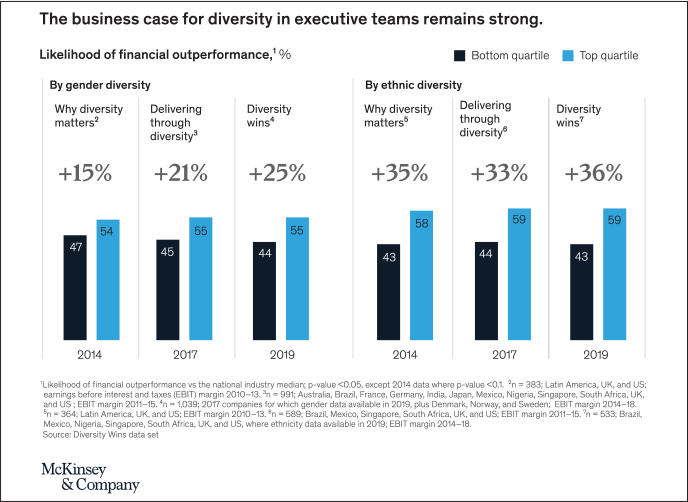
Link to digital version of article in MHI Solutions.
Many organizations have embraced the importance of diversity, equity and inclusion (DEI) initiatives for a variety of reasons, one of which being the belief that doing so will positively impact the bottom line. How? Through better ability to attract and retain top talent, to more accurately reflect the customers within their markets, to enhance employee satisfaction, and to foster creativity and innovation from collaboration across different perspectives.
How much of an impact on the bottom line does DEI have? A significant one, according to McKinsey.

The firm has been researching this topic since 2014, releasing the third edition of its latest findings last year. The report, “Diversity Wins: How Inclusion Matters,” again found a robust business case for building a diverse workforce across all levels. It noted that the correlation between a more diverse (gender, ethnic and cultural) executive leadership and the probability of financial outperformance over less diverse competitors continues to grow. Specifically:
- Companies in the top quartile for gender diversity among executives were 25% more likely to have both above-average profitability than companies in the fourth quartile.
- More women executives equates to a higher likelihood of outperformance. Organizations with more than 30% female corporate leaders proved more apt to outperform companies with 10% to 30% women executives. Likewise, these companies typically outperform those with even fewer (or no) female leaders. The difference in overperformance potential between companies with the most versus the least female leadership? A sizeable 48%.
- Companies in the top quartile for ethnic and cultural diversity, likewise, outperformed those in the fourth quartile by 36% in profitability. The research also found that diversity in ethnicity increases the probability of outperformance more than gender.
The report’s findings do not surprise Yedidah Glass, North American marketing manager at MHI Member Doosan Industrial Vehicle America Corp. (DIVAC) and member of MHI’s Diversity, Equity, and Inclusion (DEI) Committee.
“Diversity allows for an even greater mix of experience and knowledge from a broader base within and outside of an organization. And it is this broader base that provides greater insight into strategies and solutions,” she said.
Diversity fosters higher performance because there is no one right perspective or path to success, she continued. “For better or worse, companies are the sum of their people. The wider the lens, the better ability one has to see from all sides. Your people and their different experiences, perceptions, and ideas are a win-win. One viewpoint only covers one area of opportunity. Many can open a world of opportunities and success.”
Glass has seen this degree of corporate outperformance and success at her own workplace. She attributed much of DIVAC’s expanded market share in the U.S. to the global company’s intense prioritization of diversity and inclusion.
“Under the strategic and forward-thinking leadership of our CEO Tony Jones, putting the best people in the right roles from diverse backgrounds has been the guiding force in our phenomenal growth. Since his appointment and the addition of our Director of HR Trena Clark, recruiting talent is driven by the strength of our differences toward a common goal,” she noted. “We recognize, embrace and celebrate our diversity, which makes us stronger inside our organization and in the marketplace. It is the soil from which our success grows.”

WWW.MCKINSEY.COM. COPYRIGHT (C) 2021 MCKINSEY & COMPANY. ALL RIGHTS RESERVED. REPRINTED BY PERMISSION.
Workplace diversity best practices
The McKinsey team dug into the efforts of most diverse companies to unearth best practices in building diversity, equity, and inclusion. The study found, “the common thread for these diversity leaders is a systematic approach and bold steps to strengthen inclusion.”
Among them, the report recommends organizations:
- Advance diverse talent across key top roles, including executive, management, technical and at the board level.
- Hold core business leaders and managers accountable for diversity, equity, and inclusion progress; don’t leave efforts solely to human resources.
- Be transparent, fair, and unbiased in opportunity and advancement by sharing data about promotions, pay, and associated criteria.
- Maintain zero-tolerance for discriminatory conduct and create parameters for inclusive, welcoming behaviors; hold leaders and employees accountable to each other for upholding those standards.
- Support and embrace all diversity through actions, including supporting employee resource groups, communicating values proactively, and surveying to validate effectiveness.
David Burton, CEO and founder of the Diverse Manufacturing Supply Chain Alliance (DMSCA), agreed with McKinsey’s best practice findings.
“The corporations that I’ve seen with successful internal diversity initiatives have all established affinity groups that span a variety of diverse populations: women, minorities, LBGTQ, and others. They engage these communities internally and offer them a forum to get together and discuss the issues, the problems, the challenges, the opportunities, and the difficulties they face— both internally and externally,” he said.
Fostering that enhanced level of understanding creates a more enlightened workforce and a more welcoming environment where people are free to articulate their concerns and share their authentic selves. That leads directly to more openness, collaboration, innovation, and greater profitability.
“If a person sees themselves as being a part of a company, they become more invested in its success. There’s no better measurement of that than a person taking pride in their work, which translates into productivity,” he said.
Further, Burton noted that an emphasis on internal diversity initiatives frequently has far ranging external impact. “DMSCA’s corporate members—such as Abbott, Johnson & Johnson, McCormick & Co., Medtronic, Intel, International Paper, Siemens—and others with successful internal diversity initiatives convey to external suppliers the expectation that they too include diversity as a component of their sustainability evaluation. This way, the need for and appreciation of HR diversity is continued throughout the ‘value chain.’”
MHI’s DEI Committee
MHI’s Diversity, Equity, and Inclusion Committee (mhi.org/about/dei) was formed recently in recognition of both the benefits and the need to be more intentional in this area.
The goal of the committee is to identify opportunities and recommend strategies to actively involve, include and invest in our communities—curating diverse, equitable and inclusive opportunities for all.
 MHI Solutions Improving Supply Chain Performance
MHI Solutions Improving Supply Chain Performance